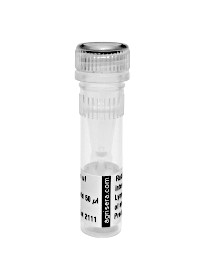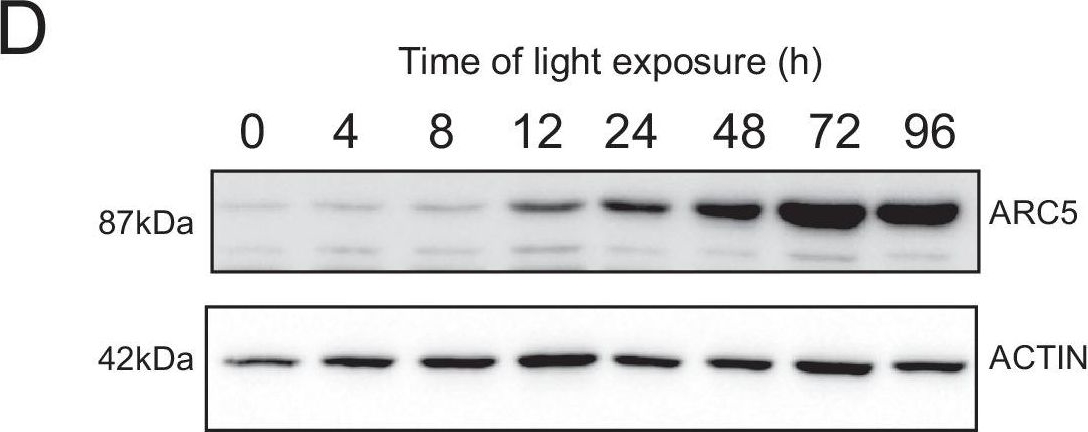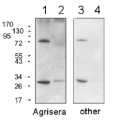1

Anti-ARC5 | Dynamin-like protein ARC5
AS13 2676 | Clonality: Polyclonal | Host: Rabbit | Reactivity: Arabidopsis thaliana
- Data sheet
-
For more information please contact us at [email protected]
- Product Info
-
Immunogen: KLH-conjugated synthetic peptide derived from internal domain of Dynamin-like protein ARC5 from Arabidopsis thaliana Uniprot: Q84N64,TAIR: AT3G19720
Host: Rabbit Clonality: Polyclonal Purity: Total IgG in Tris 0,1M, glycine 0,1M, sucrose 2%. Format: Lyophilized Quantity: 50 µg Reconstitution: For reconstitution add 50 µl of sterile water Storage: Store lyophilized/reconstituted at -20°C; once reconstituted make aliquots to avoid repeated freeze-thaw cycles. Shelf life upon re-constitution is 6 months. Please remember to spin the tubes briefly prior to opening them to avoid any losses that might occur from material adhering to the cap or sides of the tube. Store reconstituted antibodies at 4°C or in -20° for extrended periods of time. Lyophilized powder is stable for a minimum of 2 years at -20°C. Tested applications: Western blot (WB) Recommended dilution: 1 : 500-1 : 5 000 (WB) Expected | apparent MW: 87 kDa
- Reactivity
-
Predicted reactivity: Arabidopsis thaliana Not reactive in: No confirmed exceptions from predicted reactivity are currently known - Application Examples
-
Application examples: 
Reactant: Arabidopsis thaliana (Thale cress)
Application: Western Blotting
Pudmed ID: 33629953
Journal: Elife
Figure Number: 8D
Published Date: 2021-02-25
First Author: Pipitone, R., Eicke, S., et al.
Impact Factor: 7.448
Open PublicationRelationship between chloroplast proliferation and chloroplast volume.(A–B) Chloroplast number and cell volume in cotyledons of 3-day-old, dark-grown Arabidopsis thaliana seedlings illuminated for 0 hr (T0), 4 hr (T4), 24 hr (T24), and 96 hr (T96) in continuous white light (40 µmol/m2/s). (A) Chloroplast number per cell during de-etiolation. Error bars indicate ± SD (n = 6 for T0 and T4; seven for T24; five for T96). (B) Cell volume was quantified by the Labels analysis module of Amira software. Error bars indicate ± SD (n = 5–6). (C–D) Total proteins were extracted from T0–T96 seedlings, separated on SDS-PAGE, and transferred onto nitrocellulose. Proteins involved in plastid division (C, FtsZ; D, ARC5) and loading control (actin) were detected using specific antibodies (FtsZ2 antibody recognizes both FtsZ2-1 and FtsZ2-2). (E) Volume of dividing chloroplast at T24 and T96. Error bars indicate ± SD (n = 3). Further details of chloroplast proliferation in parallel with cell expansion are provided in Figure 8—figure supplement 1.Figure 8—source data 1.Quantitative data for chloroplast number, cell and chloroplast volumes.Quantitative data for chloroplast number, cell and chloroplast volumes.Chloroplast proliferation in parallel with cell expansion.SEM micrographs of 3-day-old, dark-grown Arabidopsis thaliana (Columbia) seedlings illuminated for 0 hr (T0; A), 4 hr (T4; B), 24 hr (T24; C), and 96 hr (T96; D) in continuous white light (40 ?mol/m2/s). Palisade (PA) and spongy (SP) cells are indicated. Scale bars: 15 ?m. (E) 3D reconstruction of a palisade cell at T24 after segmentation of chloroplasts and cell plasma membrane. (F–I) Confocal images of cotyledons of dark-grown seedlings at T24 (F), T48 (G), T72 (H), and T96 (I). Scale bars: 10 ?m. (J–M) TEM micrographs of cotyledon cells of dark-grown seedlings at T24 (J), T48 (K), T72 (L), and T96 (M). (J–K), scale bars: 2 ?m; L–M, scale bars: 5 µm. (N) Cell perimeter measured with Amira software using (red line). The Z-depth of each stack corresponds to 1 ?m. Relative chloroplast number per cell was counted using 2D TEM images (black line). Red error bars indicate ± SD (n = 17). Black error bars indicate ± SD (n = 3–4). (O) Single chloroplast volume quantified at T48 and T72. Data indicate mean ± SD (n = 5). (P) Examples of chloroplasts selected for the quantification of the volume of chloroplast in division at T24 and T96.
- Additional Information
-
Additional information (application): Antibody format is a total IgG (purified on Protein A) - Background
-
Background: ARC5 (Dynamin-like protein ARC5) is a probable GTPase component of both plastid and peroxisme division machinery. Required for the last steps of plastid division specifically in mesophyll-cell, when the narrow isthmus breaks, facilitating the separation of the daughter plastids. Necessary for peroxisome activities. Seems to influence stromule (stroma-filled tubular extensions of the plastid envelope membrane) length and frequency.
Alternative names: Dynamin-related protein 5B Protein ACCUMULATION AND REPLICATION OF CHLOROPLASTS 5. - Product Citations
-
Selected references: Pipitone et al. (2021). A multifaceted analysis reveals two distinct phases of chloroplast biogenesis during de-etiolation in Arabidopsis. Elife. 2021 Feb 25;10:e62709. doi: 10.7554/eLife.62709. PMID: 33629953; PMCID: PMC7906606.
- Reviews:
-
This product doesn't have any reviews.



